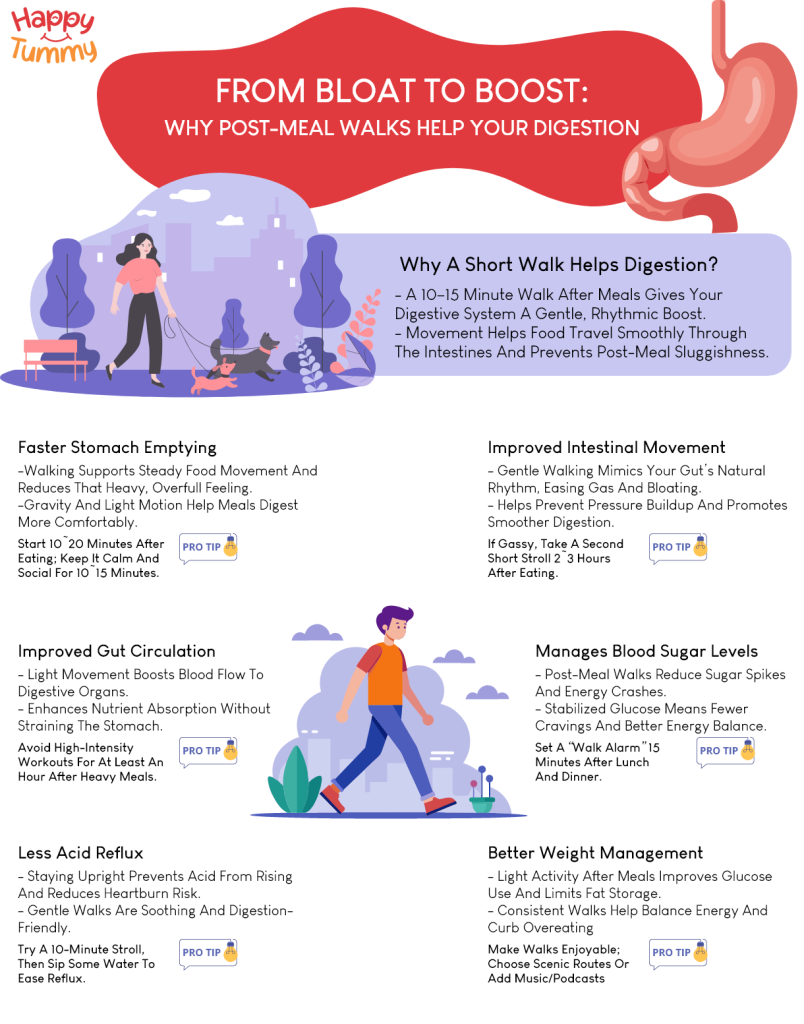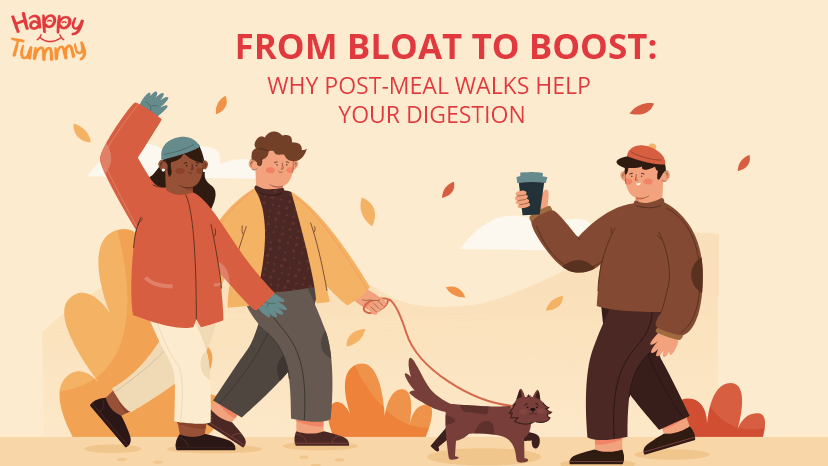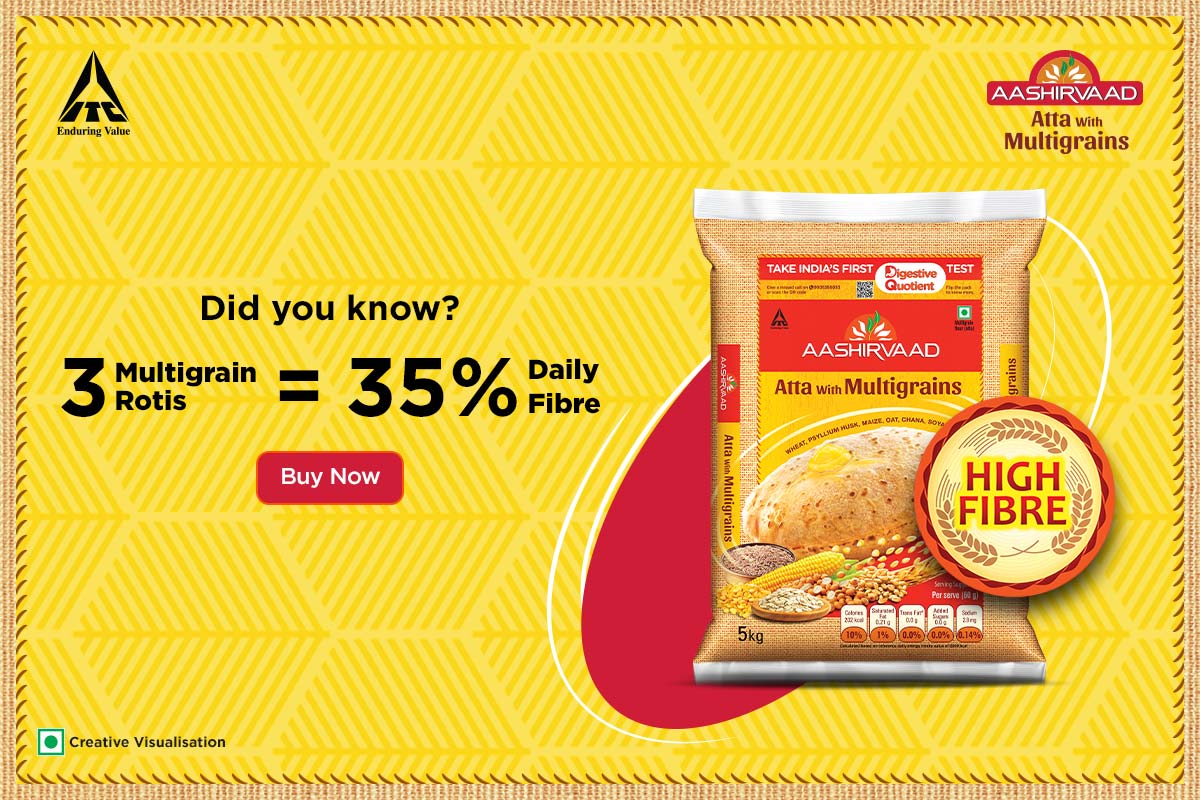Table of Contents
Don’t feel weighed down. If your meals leave you feeling tired and bloated, the most straightforward answer could be to get up and move. A brief, leisurely walk may wake up your digestion, ease discomfort after a meal, and even keep those sneaky sugar surges in check.
Just steps, no gym gear or devices. In this article, we’ll explain how walking after a meal helps your stomach move, what time and speed work best, and how to make it a habit you love. Are you ready to move from bloated to boosted?
Put on your shoes, go outside, and let your stroll after a delicious meal do the rest.

Why a Short Walk Helps Digestion
Digestion isn’t simply about chemicals; it’s also about moving.
A simple 10 to 15-minute walk after eating offers a rhythmic “assist” that helps your intestines move food along easily and stops you from feeling lethargic after a meal. This is what that walk is doing for you:
1. Faster Stomach Emptying
A quick stroll helps your stomach move food along at a steady rate.[1] Gravity and moderate motion may manage meals from being too heavy. This allows you not to feel so full and heavy after meals. You feel better, faster and less burdened down. Start 10 to 20 minutes after you finish eating.
Pro Tip: Aim for 10 to 15 minutes at a calm, sociable pace.
2. Improved Intestinal Movement
Your stomach moves food and gas by squeezing them in waves. Your belly frequently follows the steady beat of walking. Those waves push air and trash ahead so that pressure doesn’t build up. That means less bloating and improved digestion.[2] For comfort, slow walk is preferable.
Pro Tip: If you’re gassy, take a second short stroll 2–3 hours after eating.
Aashirvaad Atta with Multigrains created the Digestion Quotient. You can now find out how well your digestive system is working by completing a two-minute quiz that asks you questions about it.
3. Improved Gut Circulation
Strolling may make blood flow better all throughout your body. Your digestive organs receive the consistent supply they need to perform correctly. It doesn’t take much effort; therefore, it doesn’t take blood away from the belly. This may help your body break down and absorb your food more easily. You could feel less heavy and more comfortable.[3]
Pro Tip: Don’t do high-intensity workouts for at least an hour following substantial meals.
4. Manages Blood Sugar Levels
Your blood sugar gives your muscles the energy they need to move.[4] This softens the post-meal spike that can make you sleepy.
A steady sugar level implies more energy and fewer cravings later. So even a 10-minute walk will help. For the most outstanding results, exercise and eat balanced meals at the same time.
Pro Tip: Set a “walk alarm” for 15 minutes after lunch and supper to help you get into the habit.
5. Less Acid Reflux
Staying upright keeps the acid in your stomach from rising. A gentle stroll is relaxing and won’t make your tummy jump like a rigorous workout.
If you lie down immediately after eating, acid might go up, which can further cause GERD(gastroesophageal reflux disease).[5] Short, easy walks after heavy meals may help with heartburn. Don’t wear tight waistbands or bend too much.
Pro Tip: If your reflux is acting up, try strolling for 10 minutes and then drinking some water.
6. Better Weight Management
A quick stroll after meals can do more than just aid digestion; it can also help you keep your weight in check.
Gentle activity helps your body use glucose more effectively, which reduces the post-meal rise in blood sugar that typically leads to fat storage.[6]
This simple habit may help keep your energy levels steady and prevent you from overeating later in the day. Post-meal walks are easier on the body and can be done for a long time. You don’t have to work out hard to get results.
Just 10 to 15 minutes of easy walking can help. To make your walk something you look forward to every day, try doing it in a beautiful place or listening to your favourite music or podcast while you walk.
Post-Meal Walking Tips
Is there a “magic minute” that makes you feel lighter after a meal? The tips below help you fulfil your curiosity and find a schedule that works for you.
- Starting Window: Finishing your meal and leaving straight away, or within around 20 minutes, may help your body become used to digesting.
- Time: Most individuals will feel best if they spend 10 to 15 minutes doing this. If you eat heavier meals, you can get a few additional minutes. If you eat lighter meals, you can get a few extra minutes.
- Frequency: Three 10-minute walks a day (after breakfast, lunch, and dinner) might build up to 30 minutes a day without making your calendar too full.
- Pace: A slow, relaxed pace could help your stomach feel better. Slow down or cut it short if it feels sloshy or crampy.
- Regulate Intensity: Doing more strenuous activity shortly after eating, such as running, could not work and might make your stomach uneasy. Keeping your effort low to moderate could be better for your stomach. For example, your heart rate goes up, but you can still talk. If you’re new to working out, start gradually and work your way up as you feel better.
- Micro-walks: Even 2 to 5 minutes of walking on hectic days could be better than sitting stationary. Even short bursts make you feel less heavy.
- Terrain And Posture: A level path and standing up straight and relaxed may help with reflux and side stitches.
- Hydration: A few sips of water after the walk could feel fine; drinking before you start might feel heavy.
- Tweak: If you’re feeling dizzy, in pain, or very full, you should wait a bit longer or choose a shorter, slower circle.
The Bottom Line
Taking a brief, simple stroll after meals could become a habit that makes you feel good. Link your walks to activities you do every day, such putting on shoes, walking outside, and clearing the table. This will help you make them a normal part of your day.
To make the habit more complete, add some moderate supports: chew properly, keep quantities reasonable, put the phone away, get enough sleep, and deal with stress.
Remember that everyone’s body is different, so what feels nice may change from day to day. You should speak to a doctor if you have health problems or symptoms that concern you.
It’s not simply walking or working out that helps with digestion; eating a balanced diet is also essential.
Aashirvaad Atta with Multigrains worked with well-known dietitians to produce the My Meal Plan test. The test finds out how much fibre you consume every day and then makes a meal plan that works for you.
Frequently Asked Questions
A comfortable, talk-friendly pace for around 10 minutes may be adequate to help digestion without making your stomach uncomfortable.
A brief, gentle stroll in an upright position 10–20 minutes after eating could help, but if your symptoms become worse, you should slow down or skip it and see a doctor.
Yes, walking after meals can help with bloating by making it easier for food to flow through the digestive system.
A leisurely 10–15-minute walk helps digestion by relieving gas and that heavy, uncomfortable feeling.
















